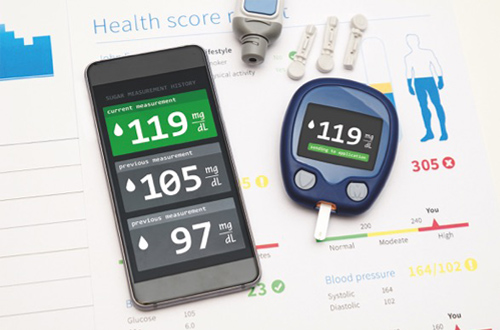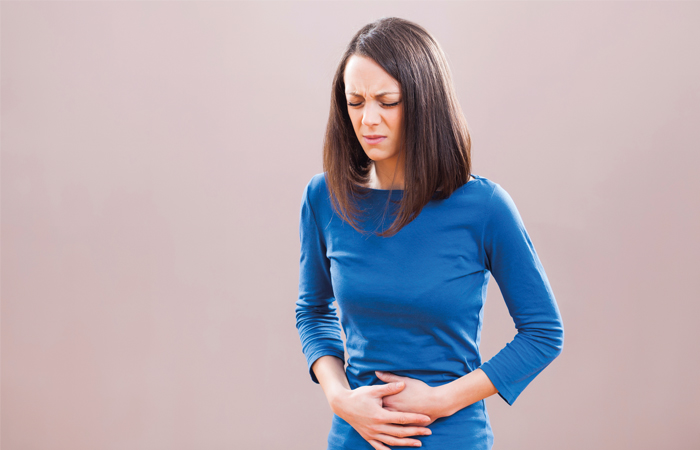There's an app for that
In Conditions
Follow this topic
Bookmark
Record learning outcomes
From calorie counters to ovulation prediction, there are plenty of health apps out there claiming to simplify women’s self care and keep them well. But are these helpful, or might there be a downside to encouraging women to track their every health move?
Smartphone ownership has skyrocketed in the decade since the launch of the first iPhone in July 2008, with the apps that run on these devices quickly becoming an indispensable feature of everyday life.

In its Data-Powered Health report, strategic insight company Opinium Research claims that the overwhelming majority (97 per cent) of UK adults now own a connected device, ranging from smartphones and smart TVs to wearable fitness bands, and these have led to a growing appetite for health technology.
There are already hundreds of thousands of health-related apps – commonly referred to as mHealth apps – available that claim to help with mental and physical self care and self improvement, as well as channelling the data they collect back to healthcare providers. And their user base is growing, particularly among women. The latest data from Mintel shows that 25 per cent of UK consumers who use mobile apps at least once a month say they use fitness or health apps, rising to 27 per cent of women overall and 35 per cent of women aged 16-34.
The evidence
But do health apps help users reach and stick to their health goals? As ever, there is research falling on both sides of the question.
One study from 2016 found, for example, that users who track activities more frequently on average tend to lose more weight than their peers who track less frequently. Another study from the previous year claims that people who use exercise apps are more likely to work out in their spare time, compared to those who don’t use them.
On the down side, researchers recently found a link between fitness or calorie-counting apps and eating disorder attitudes and behaviours.
Conversely, another study from 2016 found that young adults who used fitness monitors actually lost less weight than those who didn’t, over the same period. The researchers theorised that this could be because those wearing the trackers may have given up when it was clear that they weren’t going to reach their goal, and concluded that devices that monitor and provide feedback on physical activity may not offer an advantage over standard weight loss approaches.
And of course, health apps have hit the headlines recently with calls for more research into apps that claim to use ‘smart algorithms’ to help women monitor their fertility, after their use has been linked to unwanted pregnancies. An advert for a fertility app, described as a “highly accurate” method of birth control, has recently been banned by the Advertising Standards Authority for being misleading and exaggerating the app’s effectiveness, which was in fact “significantly lower than most reliable methods”.
Goal setting
David Priestley, chief digital officer at health and life insurer VitalityHealth, sees a lack of support for app users as an obvious hurdle to their efficacy. “Devices and apps are a great way for everyone to monitor their activity,” he says, “but these don’t always provide the necessary guidance to users in terms of appropriate levels of activity and personalised targets.”
In addition, he says that the lack of “a tangible reward” means people have to “rely largely on their own motivation to sustain their engagement”. With this in mind, VitalityHealth introduced its Active Rewards incentive program, which gives members ways to monetise their activity by earning benefits such as free cinema tickets and lower insurance premiums. However, he admits that to make this work, the devices and apps still need to “integrate seamlessly and connect close to real time with minimal effort for the consumer”.
One solution, according to Opinium, is for app developers to look at the factors preventing infrequent users of health apps from using them more regularly. Their research suggests that the top reasons for non-sustained usage are lack of time (24 per cent), boredom with the app (24 per cent) and that the app got too complicated to use regularly (42 per cent). Their suggestion is for app companies to create simpler, better apps that provide the features of most interest to consumers to increase retention rates.

Benefiting healthcare services
Another upside of greater user retention is the benefit to health and care services.
For example, in its 2015 report Uptake and use of mHealth apps, the IMS Institute for Healthcare Informatics said that using health apps is particularly useful in “therapy areas which require chronic disease management and have high costs to the healthcare system such as congestive heart failure (CHF), chronic obstructive pulmonary disease (COPD) and diabetes.” The report added that this is due to “the mHealth benefits around patient adherence and the ability to more effectively monitor patient vitals”.
Oliver Gower, product manager of digital pharmacy at Well, says the “frictionless patient journey” is another benefit – something that should appeal to women juggling increasingly busy lives. “Many of these apps are looking to tackle and reduce waiting times so that people can gain access to expert advice quicker,” says Oliver. “They also give people who are unable to leave the house or who may be embarrassed to have a conversation with someone in person, the opportunity to seek the help they need.”
When it comes to the wider reach of the health information that apps collect, Opinium research shows that people are more willing to allow their personal health data to be shared if they have a clear idea of where and how it is being used. Some 55 per cent would be willing to share their personal health records if it meant that new and more effective treatments could be developed faster, while the same proportion would be willing to share their data if it meant they would personally benefit from more effective treatment. Interestingly, men are slightly more likely to be inclined to share their data (59 per cent) than women (52 per cent).
NHS apps
For customers who want to open up the vast virtual medicine cabinet of health apps but don’t know where to start, the newly updated NHS App Library is a good option.
Launched in April 2017 the library clocked up 70 available apps to mark the 70th birthday of the NHS in July. The library covers a diverse range of topics including support to prevent and manage diabetes, mental health apps and a whole section of apps aimed at pregnant women and mothers, including Peanut, which connects mothers to meet up and share parenting advice and Squeezy, which helps women to remember to do their pelvic floor muscle (kegel) exercises.
And tech-savvy customers hoping for an even more joined-up digital health experience won’t have long to wait. December sees the launch of a new, free NHS app available to everyone in England that can be used to make GP appointments, order repeat prescriptions, manage long-term conditions and access 111 online for urgent medical queries, as well as being able to state their preferences relating to data sharing, organ donation and end-of-life care.
Encouraging customers to explore relevant, trustworthy and engaging apps to improve their health outcomes can become part of the face-to-face advice given to them in the pharmacy. Being as knowledgeable about these as possible will add an extra layer of advice to customer interactions, which can increase the likelihood of them returning for further advice and support in future.
Researchers recently found a link between fitness or calorie-counting apps and eating disorder attitudes and behaviours
Common women’s health issues

Dysmenorrhoea
It is estimated that over half of women in the UK get period pain (dysmenorrhoea), which occurs when the muscular wall of the womb tightens (contracts) to encourage the womb lining to shed away as part of a woman’s monthly period. The body also produces prostaglandins – chemicals that encourage the womb muscles to contract more, further increasing the level of pain.
Pharmacy staff can recommend OTC pain relief, such as the non-steroidal anti-inflammatory drugs (NSAIDs) ibuprofen and naproxen. Another way to relieve pain is with a hot water bottle, self-heating patch or pack that is heated in the microwave.
It is also thought that taking vitamin B6 regularly can help, as it seems to have a direct effect on the pain and facilitate the break down of excess oestrogen, and many women find that taking magnesium helps prevent menstrual cramping.
Hot flushes
Hot flushes and sweating are the most common symptoms of menopause, and can make the process particularly unpleasant.
For women who are embarrassed by heavy sweating, it can help to wear light clothing in layers, drink plenty of water and keep hot drinks, alcohol and spicy foods to a minimum.
Those who have trouble sleeping due to night sweats can find sleeping aids and supplements beneficial, as they contain nutrients that may help maintain hormone balance. Those containing vitamin E may help with hot flushes, vitamin B complex may help contribute to a normal balance of nutrients and vitamin D may help maintain calcium levels in the body.
Thrush
Thrush is a yeast infection caused by the candida fungus. It most commonly occurs as vaginal thrush in women in their 30s and 40s when the pH or acid balance in the body becomes disturbed, causing the fungus to multiply and result in intense itching
and soreness.
Thrush is often caused by taking antibiotics, as these kill other harmless bacteria allowing the candida fungus to thrive, but vaginal thrush can also be a result of hormonal changes that take place during pregnancy or menstruation, poorly-controlled diabetes, perfumed bath products and wearing tight or synthetic clothing. Poor toilet hygiene can be another contributing factor, as candida is present in the bowels and can easily pass to the vagina.
Treatments usually contain an antifungal agent such as clotrimazole, which aims to reduce the level of candida infection in the body. This is available in antifungal pessaries, which are inserted into the vagina with a special applicator, or in the form of intravaginal creams. Topical creams can also help to soothe itching. Alternatively, an oral capsule containing fluconazole can be used to treat an infection.
Bacterial vaginosis
Despite bacterial vaginosis (BV) being the most common vaginal infection, 57 per cent of UK women do not know about it, and 66 per cent confuse it with thrush.
BV is a change in pH levels and symptoms including vaginal odour and a thin, white-grey discharge, whereas thrush symptoms are itching and a thick, white, odourless discharge.
There is a variety of OTC products available that can help restore and preserve the natural pH balance.
Cystitis
A urinary tract infection that results in inflammation of the bladder, cystitis is caused when bacteria grow in the bladder.
Common symptoms include pain and frequency, urgency and difficulty in passing urine. If left untreated, a serious kidney infection may develop, so if a customer has suffered for more than 24 hours they should see a GP.
Sensible steps to prevent cystitis include drinking plenty of fluid and avoiding tea, coffee and alcohol; passing water every three to four hours; and avoiding douches or highly perfumed toiletries.
Morning after pill
Pharmacy is the first port of call for emergency contraception (EHC) for many women. The latest national EHC guidance from the Faculty of Sexual and Reproductive Healthcare (FSRH) states that ulipristal acetate has been demonstrated to be more effective than levonorgestrel and should be considered as the first line oral EHC for women.
However, there is still a stigma attached to requesting EHC, according to Emma Marsh, brand manager at HRA Pharma (UK & Ireland). “In a recent survey conducted by HRA, 46 per cent of those surveyed had unprotected sex in the last year, but of these only 27 per cent took EHC,” she says. “This is due to a range of factors; from lack of category education, to the stigma of collecting the morning after pill from the pharmacy.”
To help break the taboo, HRA Pharma is launching its ‘My Morning After’ campaign this September to encourage a wider conversation about emergency contraception and support women who want to take the morning after pill. My Morning After will have its own microsite and roll out in print and on social media using the hashtag #MyMorningAfter.
Pharmacy staff should keep up to date with the latest guidance from the FSRH and can access HRA Pharma’s online free EHC CPD module.
